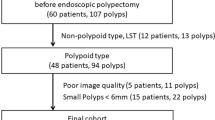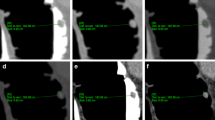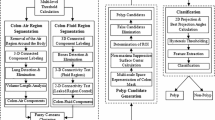Abstract
Purpose
Automated measurement of the size and shape of colon polyps is one of the challenges in Computed tomography colonography (CTC). The objective of this retrospective study was to improve the sensitivity and specificity of smaller polyp measurement in CTC using image processing techniques.
Methods
A domain knowledge-based method has been implemented with hybrid method of colon segmentation, morphological image processing operators for detecting the colonic structures, and the decision-making system for delineating the smaller polyp-based on a priori knowledge.
Results
The method was applied on 45 CTC dataset. The key finding was that the smaller polyps were accurately measured. In addition to 6–9 mm range, polyps of even <5 mm were also detected. The results were validated qualitatively and quantitatively using both 2D MPR and 3D view. Implementation was done on a high-performance computer with parallel processing. It takes \({\sim }4\) min for measuring the smaller polyp in a dataset of 500 CTC images. With this method, \({\hbox {TPR}}=87.5\% , {\hbox {TNR}}=82\%, {\hbox {PPV}}=94.45\%, {\hbox {NPV}}=64.28\%, F1\, score=90.66\%\) and \(acuracy=86.27\% \) were achieved.
Conclusions
The domain-based approach with morphological image processing has given good results. The smaller polyps were measured accurately which helps in making right clinical decisions. Qualitatively and quantitatively the results were acceptable when compared to the ground truth at \(\alpha =5\% \).












Similar content being viewed by others
References
Siegel R (2013) Colorectal cancer facts and figures 2011–2013. American Cancer Society. http://www.cancer.org/research/cancerfactsfigures/colorectalcancerfactsfigures/colorectal-cancer-facts-figures-2011-2013-page. Accessed 19 June 2016
Chu LL, Weinstein S, Yee J (2011) Colorectal cancer screening in women: an underutilized lifesaver. AJR Am J Roentgenol 196(2):303–310. doi:10.2214/AJR.10.5815
Sleisenger Mark F, Lawrence SF, Lawrence JB (2010) Gastroenterology and liver diseases, 9th edn. Elsevier, Philadelphia
Summers RM, Liu J, Yao J, Brown L, Choi JR, Pickhardt PJ (2009) Automated measurement of colorectal polyp height at CT colonography: hyperplastic polyps are flatter than adenomatous polyps. AJR Am J Roentgenol 193(5):1305–1310. doi:10.2214/AJR.09.2442
Hodadoostan MK, Reza F, Elham M (2010) Clinical and pathology characteristics of colorectal polyps in Iranian population. Asian Pac J Cancer Prev 11:557–560
Song B, Zhang G, Lu H, Wang H, Zhu W, Pickhardt PJ, Liang Z (2014) Volumetric texture features from higher-order images for diagnosis of colon lesions via CT colonography. Int J Comput Assist Radiol Surg 9(6):1021–1031. doi:10.1007/s11548-014-0991-2
An S, Lee KH, Kim YH, Park SH, Kim HY, Kim SH, Kim N (2008) Screening CT colonography in an asymptomatic average-risk Asian population: a 2-year experience in a single institution. AJR Am J Roentgenol 191(3):W100–W106. doi:10.2214/AJR.07.3367
www.hopkinsmedicine.org (2016) John Hopkins Medicine: Colon cancer. http://www.hopkinsmedicine.org/kimmel_cancer_center/types_cancer/colon_cancer.html. Accessed 23 June 2016
Lee JG, Kim JH, Kim SH, Park HS, Choi BI (2011) A straightforward approach to computer-aided polyp detection using a polyp-specific volumetric feature in CT colonography. Comput Biol Med 41(9):790–801. doi:10.1016/j.compbiomed.2011.06.015
Huang A, Li J, Summers RM, Petrick N, Hara AK (2010) Improving polyp detection algorithms for CT colonography: pareto front approach. Pattern Recognit Lett 31(11):1461–1469. doi:10.1016/j.patrec.2010.03.013
Jian WX, Suzuki K (2014) Max-AUC feature selection in computer-aided detection of polyps in CT colonography. IEEE J Biomed Health Inform 18(2):585–593. doi:10.1109/JBHI.2013.2278023
Van R, Zhao L, Botha CP, Post FH (2009) Combining mesh, volume, and streamline representations for polyp detection in CT colonography. In: IEEE international symposium on biomedical imaging: from Nano to Macro, Boston, pp 907–910: doi:10.1109/ISBI.2009.5193200
Bevilacqua V (2011) A 3D virtual colonoscopy computer aided measurements: a new framework. In: IEEE international workshop on medical measurements and applications proceedings, Bari 564–8: doi:10.1109/MeMeA.2011.5966770
Van R, Wijk VC, Vos FM, Truyen R, Peters JF, Stoker J, Vliet LJ (2010) Computer-aided detection of polyps in CT colonography using logistic regression. IEEE Trans Med Imaging 29(1):120–131. doi:10.1109/TMI.2009.2028576
Wang S, Yao J, Summers RM (2008) Improved classifier for computer-aided polyp detection in CT colonography by nonlinear dimensionality reduction. Med Phys 35(4):1377–1386. doi:10.1118/1.2870218
Pickhardt PJ, Lehman VT, Winter TC, Taylor AJ (2006) Polyp volume versus linear size measurements at CT colonography: implications for noninvasive surveillance of unresected colorectal lesions. AJR Am J Roentgenol 186(6):1605–1610. doi:10.2214/AJR.05.0760
www.cancerimagingarchive.net (2016) National Cancer Institute (NCI). https://public.cancerimagingarchive.net/ncia/login.jsf. Accessed 27th Feb 2016
ACRIN Protocol 6664 (2013) American College of Radiology Imaging Network. https://www.acrin.org/TabID/151/Default.aspx. Accessed 19 June 2016
The DICOM PS 3.3 (2012) NEMA USA. http://dicom.nema.org/standard.html Accessed 19 June 2016
Johnson CD, Chen MMM, Toledano AY, Heiken JP, Dachman A, Kuo MD, Menias CO, Siewert B, Cheema JI, Obregon RG, Fidler JL, Zimmerman P, Horton KM, Coakley K, Iyer RB, Hara AK, Halvorsen RA, Casola G, Yee J, Herman BA, Burgart LJ, Limburg PJ (2008) Accuracy of CT colonography for detection of large adenomas and cancers. N Engl J Med 359(12):1207–1217. doi:10.1056/NEJMoa0800996
Pickhardt PJ, Lee AD, Taylor AJ, Michel SJ, Winter TC, Shadid A, Meiners RJ, Chase PJ, Hinshaw JL, Williams JG, Prout TM, Husain SH, Kim DH (2007) Primary 2D versus primary 3D polyp detection at screening CT colonography. AJR Am J Roentgenol 189(6):1451–1456. doi:10.2214/AJR.07.2291
Manjunath KN, Siddalingaswamy PC, Gopalakrishna Prabhu K (2016) An improved method of colon segmentation in computed tomography colonography images using domain knowledge. J Med Imaging Health Inf 6(4):916–924. doi:10.1166/jmihi.2016.1786
Zhang H, Li L, Zhu H, Han H, Song B, Liang Z (2014) Integration of 3D scale-based pseudo-enhancement correction and partial volume image segmentation for improving electronic colon cleansing in CT colonography. J Xray Sci Technol 22(2):271–283. doi:10.3233/XST-140424
Van R, Boellaard TN, Van MP, Serlie IW, Haan MC, Stoker J, Vliet LJ, Vos FM (2013) Electronic cleansing for 24-h limited bowel preparation CT colonography using principal curvature flow. IEEE Trans Biomed Eng 60(11):3036–3045. doi:10.1109/TBME.2013.2262046
Lee H, Kim B, Lee J, Kim SH, Shin YG, Kim TG (2013) Fold-preserving electronic cleansing using a reconstruction model integrating material fractions and structural responses. IEEE Trans Biomed Eng 60(6):1546–1555. doi:10.1109/TBME.2013.2238937
Melancon G, Munzer T, Weikopf D (2010) Volume rendering on server GPUs for enterprise scale medical applications. In: IEEE Proceedings of symposium on visualization, Heidelberg, pp 1–10
Punwani S, Halligan S, Tolan D, Taylor SA, Hawkes D (2009) Quantitative assessment of colonic movement between prone and supine patient positions during CT colonography. Br J Radiol 82(978):475–481. doi:10.1259/bjr/91937173
Cai W, Lee JG, Zhang D, Kim SH, Zalis M, Yoshida H (2015) Electronic cleansing in fecal-tagging dual-energy CT colonography based on material decomposition and virtual colon tagging. IEEE Trans Biomed Eng 62(2):754–765. doi:10.1109/TBME.2014.2364837
Van WC, Van RVF, Vos FM, Vliet VLJ (2010) Detection and segmentation of colonic polyps on implicit isosurfaces by second principal curvature flow. IEEE Trans Med Imaging 29(3):688–698. doi:10.1109/TMI.2009.2031323
Yoshida H, Wu Y, Cai W, Brett B (2012) Scalable, high-performance 3D imaging software platform: system architecture and application to virtual colonoscopy. IEEE Eng Med Biol Soc 57(3):3994–3997. doi:10.1109/EMBC.2012.6346842
Simon EG, Nevo T, Marjolein H, Liedenbaum Truyen R, Stoker J, Vliet LJ, Vos FM (2010) Automated detection and segmentation of large lesions in CT colonography. IEEE Trans Biomed Eng 57(3):675–684. doi:10.1109/TBME.2009.2035632
Johnson CD, Herman BA, Chen MH, Toledano AY, Heiken JP, Dachman AH, Kuo MD, Menias CO, Siewert B, Cheema JI, Obregon R, Fidler JL, Zimmerman P, Horton KM, Coakley KJ, Iyer RB, Hara AK, Halvorsen RA Jr, Casola G, Yee J, Blevins M, Burgart LJ, Limburg PJ, Gatsonis CA (2012) The national CT colonography trial: assessment of accuracy in participants 65 years of age and older. Radiology 263(2):401–408. doi:10.1148/radiol.12102177
Acknowledgements
We would like to thank National Cancer Institute, USA for providing the anonymized CTC images for this research.
Funding Manipal University supported this work under Dr. TMA Pai Ph.D. Scholarship Program.
Author information
Authors and Affiliations
Corresponding author
Ethics declarations
Conflict of interest
Manjunath KN, Siddalingaswamy PC and Prabhu GK declare that they have no conflict of interest.
Ethical approval
This article does not contain any studies with human participants performed by any of the authors. For this type of study, formal consent is not required. Still, the institutional ethical committee (IEC 211/2014 dated 9th April, 2014) clearance has been obtained from Kasturba Hospital, Manipal to use the secondary data in this study.
Rights and permissions
About this article
Cite this article
Manjunath, K.N., Siddalingaswamy, P.C. & Prabhu, G.K. Measurement of smaller colon polyp in CT colonography images using morphological image processing. Int J CARS 12, 1845–1855 (2017). https://doi.org/10.1007/s11548-017-1615-4
Received:
Accepted:
Published:
Issue Date:
DOI: https://doi.org/10.1007/s11548-017-1615-4




